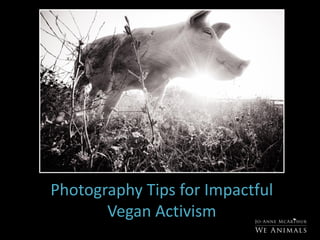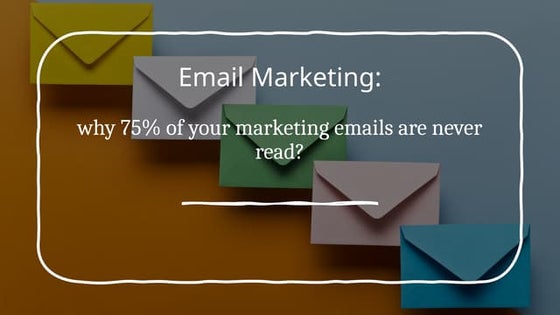Photography Tips for Impactful Vegan Activism - VegFund Webinar
- 1. Photography Tips for Impactful Vegan Activism
- 2. Facebook, Instagram, Twitter, YouTube: @weanimals Email: info@weanimals.org
- 3. A bit about meŌĆ” Activist 20+ years Photographer 20+ years Shoots and speaking engagements in 60+ countries
- 11. Why is photography so important for social change? Because most often, we canŌĆÖt understand, we canŌĆÖt imagine or empathize, if we canŌĆÖt see.
- 12. Images shape history. Migrant Mother. 1936. Photo by Dorothea Lange Tiananmen Square, 1989. Photographer: Jeff WidenerHuynh Cong Ut, 1973. Vietnam war.
- 13. Both historically and today, photographs bring war home. Execution of a Viet Cong, Eddie Adams, 1968 Aylan Kurdi, Syrian migrant boy, 2015
- 14. Images create empathy and they hold us accountable. Gordon, a runaway slave in, Louisiana 1863
- 16. Marianne Thieme, Founder of the Dutch Party for Animals Proof not just of the bad, but of the good.
- 18. Images show us what is, and what should never again be.
- 19. Beyond influencing public opinion, images have also been used in criminal cases, influenced moratoriums and have helped change policies.
- 20. Working on investigations with films and organizations means we can get places like these held accountable or even closed.
- 21. Our work on behalf of animals is historic. Treat it that way.
- 23. We have to understand that weŌĆÖre asking a lot of our audience. To face cruelty is to face our complicity in that cruelty. To face suffering is to face ourselves. Regarding the suffering of othersŌĆ”.
- 24. For the most part, the general public in most countries is not ready to see the world through the lens of animal rights.
- 25. Some challenges when trying to get into mainstream publications: Work seen as subjective by default, or misanthropic Subject matter unimportant Subject matter unimportant compared to other animals Media doesnŌĆÖt want to upset investors and advertisers Media can be inherently conservative
- 26. Part of our job as photographers is to put a face to the billions of animals we consume each year.
- 27. When you get close you remove the anonymity of those you photograph, you individualize the masses.
- 30. ItŌĆÖs equally important to make people smile and connect.
- 32. The use of humour is really important in photos and campaigns.
- 33. If we could live happy and healthy lives without harming others, why wouldnŌĆÖt we? ŌĆō EdgarŌĆÖs Mission
- 34. BeforeŌĆ”.. We canŌĆÖt simply paralyze people with the depressing reality of how we treat animals.
- 35. Rescued capuchin at Jungle Friends Sanctuary, USA ŌĆ”and after.
- 36. Show that there are different ways of being with animals.
- 38. Photos are important. Stories are better. Be a hunter of stories. Sometimes you can get a full story in a single image.
- 41. Pepsi, at Save the Chimps Sometimes the written or spoken story brings the image to life.
- 42. Abbey, from the film The Ghosts in Our Machine
- 43. What we see, what we are shown, is often the surface of things. Dig ever deeper with your shoots and your work.
- 46. We suffer from cognitive dissonance. This is defined as an inconsistency between oneŌĆÖs beliefs and oneŌĆÖs actions.
- 47. PHOTO ESSAYS: When planning for a shoot or story, write out your goals. Plot a narrative so that you achieve the best possible shoot.
- 48. RachelŌĆÖs Promise. Ape Action Africa, Cameroon
- 62. EveryoneŌĆÖs most pressing question: How do I gain access?
- 63. Street photography. Once you start looking, there are stories everywhere.
- 64. Ask permission:
- 66. OrŌĆ”if you donŌĆÖt ask permissionŌĆ”.
- 67. There are of course legal and safety risks. Legal ŌĆō it depends on which country or state you are working in. Find out ahead of time what the risks are. Examples: fines, jail, eco-terrorism charges. Have a lawyerŌĆÖs phone number written on your arm. Safety ŌĆō there is no doubt about it, you are at physical and emotional risk. Examples: leg traps, ambush, violence and injury, property damage, being chased and hit by cars, depression, despairŌĆ”
- 68. Buy a ticket, sit in the front rowŌĆ” (bullfight, rodeo, circus)
- 69. Because of films like Blackfish, and events like the cull of Marius the giraffe and the shooting of Harambe the gorilla, the ethics of captivity are being discussed globally NOW.
- 70. The challenge can be to show things in a way that we donŌĆÖt normally see them.
- 71. I aimed to show the perversity of captivity, the loneliness, the absurdity of the spaces in which we keep them. Again, getting us to self-reflect and think critically.
- 72. ItŌĆÖs a very good way of getting your story seen. The stories of animals are also the stories of us.
- 73. Collaborations:
- 74. Collaborations. Make a list of the pros and cons: Is there funding to get the work done? Are they good at marketing? Do they have a vision and a strategy?
- 75. Most importantly: SHOW UP.
- 76. Some simple techniques to use and look for. This is important not just if youŌĆÖre a photographer, but when choosing images to illustrate your work or your point, so here are a few tips.
- 77. Interesting angles. Move your feet.
- 78. (ItŌĆÖs exciting when images are also sociological studies, like this one.)
- 79. Make time.
- 80. Get down, get close.
- 82. Change your angle, move your feet.
- 85. Lighting: Direct sunlight is not your friend.
- 86. A quick trick for better lighting: keep your subject in the shade.
- 89. Make the most of the weather youŌĆÖve been handed!
- 90. Crop.
- 91. Backlight is tricky but gorgeous when you get it right. Practice!
- 92. Lighting in complete darkness...
- 94. Hand-held light such as headlamps and light panels are sometimes better than flash.
- 95. This is a shallow/narrow depth of field. So, f2.8
- 96. Shallow depth of field (f2.8 or thereabouts) is what you want to use for portraits so that the focus is on the face and the background drops out.
- 97. This is a larger depth of field. So, f11 or more.
- 98. A large depth of field (f8, f11, f18 etc) is what you want to use when you want to show every detail in the frame.
- 99. Provide people the opportunity to inhabit your photographs. They will see themselves in the people and actions taking place.
- 100. The Jane Goodall Institute Roots and Shoots program. Inspire, guide and motivate people through photos and stories.
- 101. Also very necessary in our work: acknowledging the overlap of oppressions and working in solidarity with others to improve the lives of all.
- 102. Animal abuse intersects with labour violations and human abuse.
- 103. Animal abuse intersects with environmental abuse.
- 104. Progressive social change requires not simply liberating specific groups, but challenging the foundations of oppression itself. - Melanie Joy
- 105. A popular question: How to cope. First: I recommend these three books: Aftershock: Confronting Trauma in a Violent World. A Guide for Activists and Their Allies by pattrice jones Trauma Stewardship: An Everyday Guide for Caring for Self While Caring for Others by Laura van Dernoot Lipsky Beyond Beliefs: A Guide to Improving Relationships and Communication for Vegans, Vegetarians, and Meat Eaters by Melanie Joy
- 106. I personally recommend investing in a onesie.
- 107. Nurture joy Photo: Julie OŌĆÖNeill for the Unbound Project
- 108. Another world is not only possible, she is on her way. On a quiet day, I can hear her breathing. ŌĆō Arundhati Roy I think the future IS getting brighterŌĆ”
- 110. Author and philosopher Carol J. Adams
- 111. Shelter staff and first responder Lumka Golintete Highlighting good work empowers people!
- 113. Women in science, such as neurologist Aysha Akhtar, who specialises in preventative medicine and public health.
- 114. Animal Liberation Victoria Founder Patty Mark in Australia
- 115. Women who are part of innovative strategies, like Yenzekile Mathebula and Leitah Mkhabela of the Black Mambas.
- 116. Women who are driven by a great sense of urgency for change, like The Animal Save Movement co- founder Anita Krajnc.
- 117. Women entering the growing field of animal rights law.
- 118. Young trail-blazers like Avalon Theisen, founder of Conserve it Forward.
- 119. Innovative veterinarians like Dr. Gladys Kalema - Zikusoka in Uganda.
- 120. Women who take leaps of faith, like Raabia Hawa.
- 121. Tenacious women like Dr. Theodora Capaldo.
- 123. Take great images of animals who need homes to help them get adopted.
- 124. Be a part of the photo world and other visual arts communities.
- 125. Scrutinize the work of the masters, whoever they are to you. For me, itŌĆÖs Magnum and VII, the World Press Photo, Media Storm, Lynsey Addario. Study these big talents. Photo by Tommaso Ausili
- 126. Set your bar high. Current AR photography shouldnŌĆÖt be the bar, Nat Geo and the New York Times should be the bar. Photo by Lynsey Addario
- 127. Attend photojournalism and photography conferences. You can learn a lot simply by seeing and discussing the best photography in the world. Examples of photo conferences in Europe and the USA include: GDT, Germany (October) Perpignan Visa pour LŌĆÖImage, France (Aug/Sept) Montier-en-Der, France (November) Les Rencontres dŌĆÖArles, France World Press Photo (International) International League of Conservation Photographers, USA (November)
- 128. We Animals Media Animal Photojournalism Masterclass www.weanimalsmedia.org/masterclass
- 129. GET HELP WITH PR AND MARKETING. Most of us suck, I mean really suck, at promoting our work. Hire PR or find marketing and communications volunteers. Give this job to the experts. Evolotus Raison DŌĆÖEtre Media
- 130. Most of the time, being a successful photographer = desk job (marketing, editing, fundraising, emails, planning, writing, paperwork, etc)
- 131. www.weanimalsarchive.org Make your photos available to those helping animals
- 132. Compassion hurts. When you feel connected to everything, you also feel responsible for everything. And you cannot turn away. You must grow strong enough to love the world, yet empty enough to sit down at the same table with its worst horrors. ŌĆō Andrew Boyd
- 133. As a matter of survival, we must choose hope instead of hopelessness. Action is catharsis.
- 134. Facebook, Instagram, Twitter, YouTube: @weanimals Email: info@weanimals.org www.weanimalsmedia.org





























































































































































![Filmora Video Editor 14.2.5 Crack [Latest Version] 2025](https://cdn.slidesharecdn.com/ss_thumbnails/maranaoandlumad-250302050027-c24c7938-250302123426-a413432d-thumbnail.jpg?width=560&fit=bounds)




![IObit Driver Booster Pro Crack v11.2.0.46 & Serial Key [2025]](https://cdn.slidesharecdn.com/ss_thumbnails/lect5-250227155726-618fad5f-250301095444-eebe0061-thumbnail.jpg?width=560&fit=bounds)





